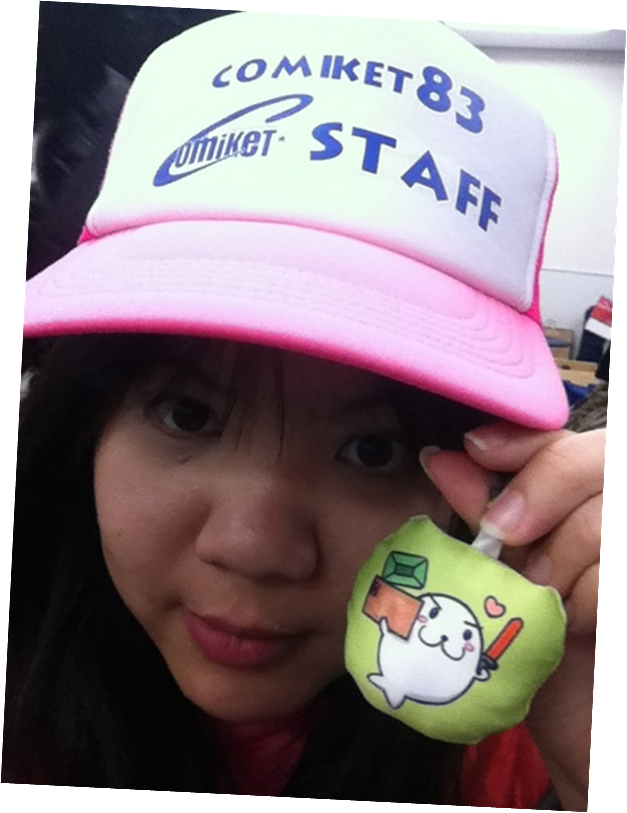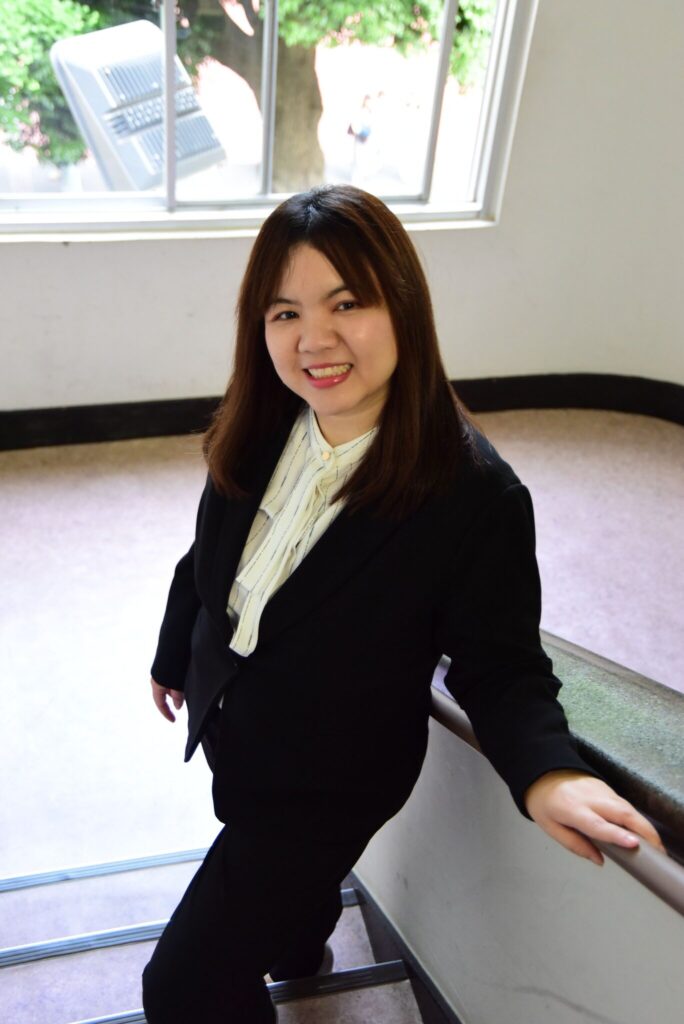Driven by a profound adoration for Japanese pop culture, Rujirat Vinitphol (Gift) transitioned from being a research student to an assistant professor, dedicating herself to sharing her expertise and igniting the younger generation’s enthusiasm for Japanese pop culture. Furthermore, she founded a Facebook page with 138,000 followers, serving as a valuable resource for Thai individuals seeking insights about Japan.
A Thai student walking through a rough patch
– Why did you come to Japan?
I’ve been fascinated by Japanese pop culture since I was a child. I grew up with Doraemon and Paaman, and my love for Japan has been a constant in my life. However, due to my lack of proficiency in the Japanese language, I needed to find scholarships that would provide Japanese language courses. That’s when I was fortunate to be selected for the Asian Youth Fellowship program – an exclusive initiative accepting only 18 scholars from 11 countries. We underwent a 7-month intensive Japanese language program in Osaka under the guidance of the Japan Foundation. Following our language studies, we embarked on our journey as Monbukagakusho Students (MEXT) at various universities.
– Was your initial impression of Japan consistent with what you had learned from animations or manga?
My perception of Japanese people included images of them donning kimonos and relishing sushi. However, my assumptions were swiftly challenged when, on my very first visit to the supermarket, I observed that no one wore kimonos at all. Furthermore, as I attempted to approach a Japanese lady to seek guidance distinguishing between fabric softeners and detergents – a distinction I was unfamiliar with – her response was unexpected; she hurriedly ran away from me. While I had heard about Japanese people harboring concerns about interacting with foreigners, I was surprised by this reaction. Thus, this encounter marked my initial day in Japan.

– Are there any cultural differences you face when you live in Japan?
When we talk about culture, I had heard that Japanese people are really good at working hard. I used to work in a Japanese IT company. It’s true, but when you think about the time you spend working compared to what you achieve, it’s not always super efficient. In Thailand, we usually have one meeting and make decisions, but in Japan, we can have up to 7 meetings before a final ceremony. Adapting to the Japanese work environment was not too hard for me, but sometimes it went beyond my idea of working hard, which is quite different from what we’re used to in Thailand. We’re taught to enjoy life and know that there’s more to it than just work.
Furthermore, it varies based on individual perspectives, but in Japan, becoming independent seems to come more naturally. I recall shedding many tears during my initial year as a research student because I found it difficult to have lunch by myself, something I had never experienced before. In Thailand, most activities are carried out together, be it eating, watching movies, or even going to the restroom. However, after spending several years in Japan, I learned to do many things alone such as having lunch, going shopping, or even singing at karaoke all night by myself. Also, I’ve come to grasp the concept of “uchi and soto” (insiders and outsiders), which applies not only to family dynamics but also to situations like being inside or outside of seminars.
However, there are still similarities between the two countries since both are in Asia. One similarity is the senpai-kohai culture (senior and junior). In Thailand, we also give respect to our elders and seniors. We also use humble and honorific language forms similar to Japanese. That’s why it’s relatively simple for Thai people to fit into Japanese society because when it comes to respecting seniority, we share some common ground.
The influence of Japanese Pop culture
– How did you feel when you get closer to Japanese culture, seeing it firsthand in the country of its origin?
In the beginning, I loved Japanese pop culture but couldn’t speak Japanese. However, as I began learning the language, watching Japanese TV, and tuning into radio broadcasts, my affection for it deepened. Being in Japan, you can become an enthusiastic fan, to the point where your wallet might take a hit. Take “Kimetsu no Yaiba” (Demon Slayer) as an example. I can read the manga, watch the anime, purchase merchandise featuring Demon Slayer imagery, play games, visit cafes with Demon Slayer themes, and more. It’s an all-encompassing experience.
– How does Japanese pop culture influence Thai youth?
Nowadays, when the topic of manga arises, our minds immediately gravitate toward Japanese manga and its associated animations. It wields a significant influence, not solely on Thai individuals, but also on people worldwide.
One of the most substantial impacts occurred when Japan’s boy love (BL) culture entered Thailand. Initially, a friend of mine faced legal consequences for selling BL novels due to their association with pornography. However, the rise of the internet propelled the popularity of BL novels. Now, you can find numerous BL novels in Thai bookstores. While these initially were translations of Japanese works, Thai authors have now begun crafting their own stories. These stories were then adapted into BL movies by television networks, based on Thai BL novels. Subsequently, these works were even exported to Japan, resulting in the availability of Thai BL products in the Japanese market.
This trend has evolved into a significant aspect of Thailand’s soft power. The Thai government has taken notice and the entertainment industry now features numerous BL dramas. This phenomenon isn’t limited to Japan but has also spread to countries like China, the Philippines, and Mexico. From a culture initially seen as taboo, the import of Japanese BL novels has transformed into Thailand’s contemporary soft power, gaining prominence both at home and abroad.
– Who are BL novels’ primary audiences and how has BL culture gradually become popular among those communities?
BL novels’ audiences are mostly heterosexual girls, and the stories are romantic. The allure extends beyond the genre itself – Japanese artistic depictions often feature exceptionally attractive male characters. This appeal lies not solely in the BL genre, but also in the abundance of handsome figures that are different from the typical individuals you can see in daily life. In the context of Thailand, BL embodies a realm of fantasy. It’s not reflective of our reality, but rather a gateway that encourages girls to embrace diverse forms of love. Over time, this evolution found its place in the market.

– Do you think pop culture is a big bridge among Asian countries?
Certainly! My knowledge of Japan comes largely from manga. I recall an instance when I surprised a Japanese acquaintance by ordering “kohada” (a type of sushi) during a meal at a sushi restaurant. It’s not a common choice for foreigners, but my familiarity with sushi from manga led me to appreciate its delightful taste. Although I hadn’t yet visited Japan at that point, I was familiar with terms like “sakura” (cherry blossom), “ohanami” (cherry blossom viewing), and the tradition of “hanabi” (fireworks) during summer festivals. This pre-existing knowledge made the transition to life in Japan much smoother, as I had gained insights into what to expect and what was important.
Considering concepts like “Oshi no Ko,” many young people in Thailand often inquire about the authenticity of these aspects of Japan. In truth, it’s an unvarnished view of Japan’s darker aspects. For instance, if you aspired to be an idol in Japan and arrived without a comprehensive understanding of both the positive and negative facets of the industry, you might encounter confusion. Maybe not necessarily always, but manga does show some reality of Japan.
What are your top 3 Japanese animations? (as of summer 2023)
Natsume Yuujinchou – This anime provides insights into Japanese culture from both positive and negative perspectives. It falls under the category of “iyashi anime” (a sub-genre of a slice of life), so whenever I feel lonely, I watch this anime. It’s remarkably calming and soothing; I’ve shed many tears while watching it, and it never fails to warm my heart. The series offers glimpses into the lives of Japanese families in both summer and winter settings.
Kimetsu no Yaiba – This anime represents the evolution, the next step in anime production. It’s exceptionally well-crafted in 3D, seamlessly blending various elements together. Naturally, it also showcases Japanese culture. I adore how its art distinctly embodies the Japanese aesthetic. While walking down the street, I’ve occasionally spotted things that remind me of scenes from the anime, prompting me to exclaim, “Oh, that’s from Kimetsu no Yaiba.” Interestingly, my Japanese friends have often responded with, “Oh no, that’s just typical Japanese culture.” This contrast has allowed me to learn a great deal.
Ikkyusan – The story of a boy whom Thai parents would like their sons to emulate: intelligent and a good son to his mother. This story delves deeply into Japanese life.
Interestingly, certain anime, like “Sazaesan”, is immensely popular in Japan, yet fail to catch on in Thailand. Initially, I couldn’t understand the reasons behind their fame, but after residing in Japan for several years, I’ve come to fully grasp the factors that contribute to their popularity.
A Facebook page about Japan for Thai people

– Could you tell us about your best project to connect Thailand and Japan?
In 2022, I was honored with the title of an “Influencer in Japanese Lifestyle” from the Embassy of Japan in Thailand through a Facebook page that serves as an informative resource for Thai individuals seeking insights about Japan. I launched this page in 2019, with my main focus being the translation of Japanese news into Thai. The impetus behind creating this platform was the realization that whenever a typhoon struck Japan, the news coverage in Thailand tended to be overly sensationalized. In response, I took it upon myself to translate and share the same information that was being broadcast in Japan. My goal was to provide a more accurate understanding of the actual events in Japan and how they were perceived by the Japanese people.
I’m dedicated to offering practical guidance to Thai residents in Japan as well as Thai tourists. This includes advice about navigating natural disasters and addressing various issues that arise in Japan. For instance, during the COVID-19 pandemic, I undertook the task of translating Japanese documents into Thai. This effort aimed to ensure that Thai individuals comprehended the necessary actions to take within Japan and the protocols for entering the country post-pandemic.
As of now, my Facebook page boasts a following of 138,000 users. Many Thai media outlets have recognized my expertise and sought interviews with me to discuss matters related to Japan.

Rujirat (Ishikawa) Vinitphol (Gift)
An assistant professor at SCCS, Aoyama Gakuin University. She received her Ph.D. from the University of Tokyo in 2020. An influencer in Japanese lifestyle through a Facebook page with 138,000 followers.
Facebook: https://www.facebook.com/GiftchanNews/
Interview and text: Mimi Le
Photos: Rujirat Vinitphol (Gift)


